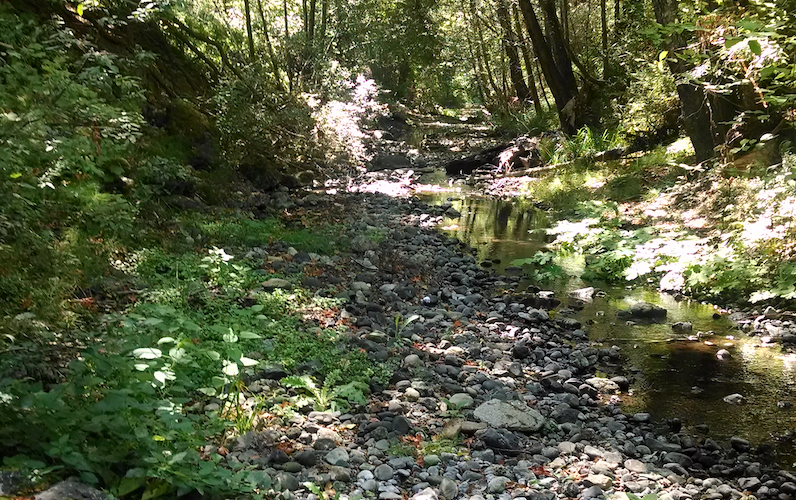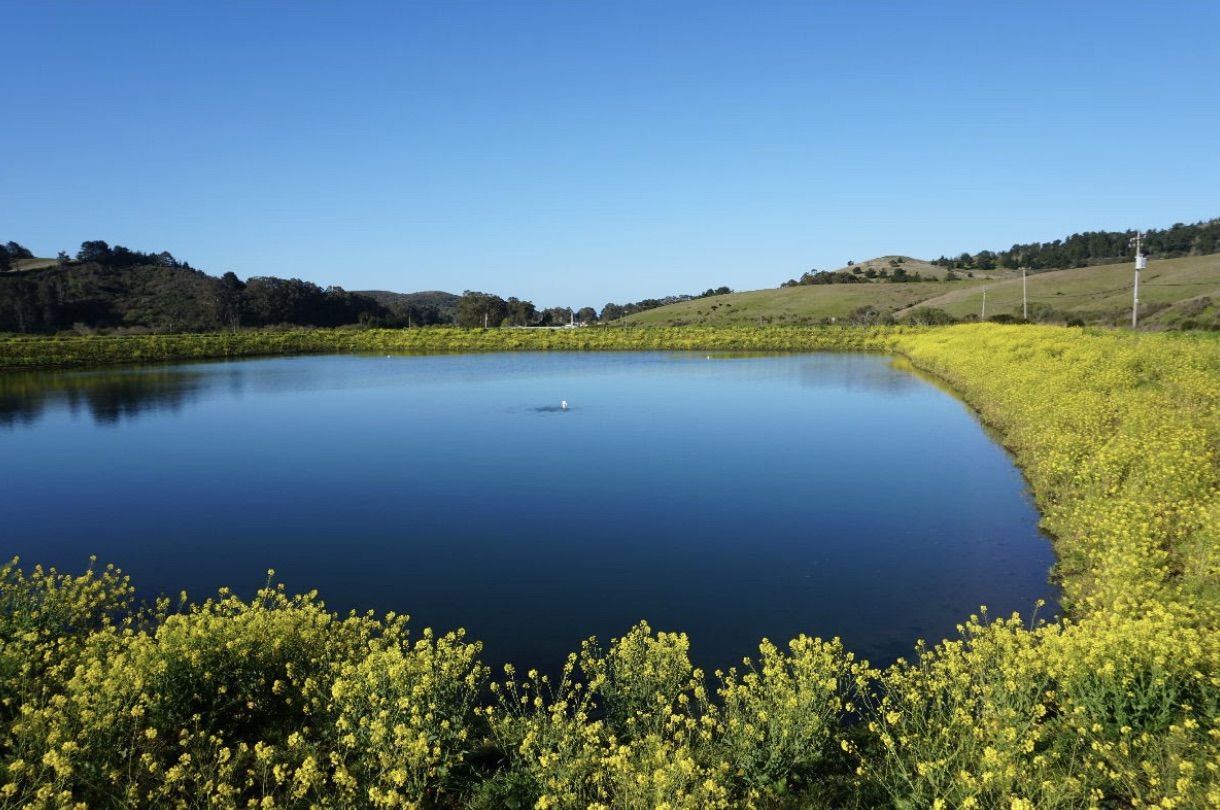|
Getting your Trinity Audio player ready...
|

The San Mateo RCD (Resource Conservation District) and its partners build a reservoir on Blue House Farm so Ryan Casey and the wildlife in the creek have more water during the drought.

San Gregorio Creek near Blue House Farm runs dangerously low during a drought. The RCD and partners built a pond for farmer Ryan Casey so he can continue irrigating his fields while not withdrawing from the at-risk creek. The pond can hold 30 acre-feet of water (nearly 15 olympic swimming pools in size)—enough for three to four months of irrigation.
In the middle of one of the worst droughts in California’s recorded history, parched grass and dry soil give way to a creek that is still running. A lucky passerby might catch a silver flash of steelhead trout; an even luckier one might see the neon blue of a San Francisco garter snake slithering through the reeds to search for its favorite prey—California red-legged frogs. Just a few summers ago, the scene looked quite different. Anxious farmers like Ryan Casey struggled to balance the competing demands of irrigating his crops and his desire to leave water in the creek for wildlife. Since then, Ryan, owner of Blue House Farm, has worked with the San Mateo Resource Conservation District (RCD) and its partners to build a pond and increase his irrigation efficiency, which allows Ryan to continue irrigating through the drought while not taking water from the creek during the driest period. This was a win-win project, improving Ryan’s water security while protecting streamflows for wildlife like threatened steelhead trout and the rare and endangered coho salmon.
The trickling flows in the creek are protected thanks in part to a 30 acre-foot pond (nearly 15 olympic swimming pools in size) full of water from winter storms, standing defiantly in the face of the dry golden hills staring down at it. While the logic that makes the reservoir work is breathtakingly simple, planning and building it took years of effort and cooperation by Ryan, the San Mateo RCD, Trout Unlimited, the Natural Resources Conservation Service (NRCS), Peninsula Open Space Trust, and many more.
The logic is this: if Ryan can divert and store water from the creek during wet winter months, he can use it to irrigate his crops in the summer months, leaving every drop of water possible in the creek during the dry season. According to Jarrad Fisher who manages the RCD’s Water for Farms, Fish and People Program, Ryan’s reservoir and others the RCD has built collectively form a support system that can effectively double the creek’s volume in the dry season.

The reservoir on Blue House Farms that the RCD and partners built allows farmer Ryan Casey to fill it in the winter and use in the summer when the flows are low. The reservoir can hold 30 acre feet of water (nearly 15 olympic swimming pools in size), leaving more water in the creek for wildlife.
That’s great news for steelhead trout and coho salmon. Full creeks give these fish access to their favorite deep, cold water where they can feed and avoid predation. They can also swim back to the ocean, completing their reproductive cycle and spawning future generations. Other threatened and endangered species like the California red-legged frog, the Western pond turtle, and the San Francisco garter snake also thrive when there is reliable water through the dry summer.
Overall, the Water for Farms, Fish and People Program has helped 25 local farms and 6 domestic water systems create 50 million gallons of additional local water storage capacity. In a summer where many farmers and ranchers will have to truck water onto the property or switch their crops out for less thirsty varieties, the program represents an increase in water security. However, water storage is not the end-all be-all solution for farmers and ranchers to weather the drought.
As Jim Howard, district conservationist for the NRCS in Half Moon Bay emphasized, “The bedrock of drought resilience for farmers and ranchers is long term planning. We can make changes here and there, but the efforts that really lead to success take time and commitment.”
The NRCS and the RCD are committed to helping farmers make those changes. They offer the technical assistance that farmers need to conserve, strategically manage, and store water. That means everything from finding and fixing leaks and broken drinking water pipes, to evaluating irrigation systems to improve water delivery and storage, to helping people navigate the complex, bureaucratic processes that make all of this work possible. But even more than all of that, the RCD and NRCS understand the art and the science of how to balance the need for water. Creating tailored, individual plans for each person they work with means that they can meet their water demands more efficiently, while leaving enough for people, fish, and farms.
If you are a farmer, rancher, or homeowner who would like to work with the RCD to improve water conservation on your land, please contact Joe Issel at [email protected].

Last fall, San Mateo RCD staff helped release 10,000 juvenile salmon into Pescadero Creek. More water in creeks increases the chance that they will thrive.

More than 90% of the San Mateo RCD’s budget comes from grants. Your donation is critical in filling the remaining gap to help protect the vitality of our landscape.Your tax-deductible donation is leveraged at about a 9:1 ratio, making it a very effective use of your charitable dollars.
With your support, the San Mateo RCD can help wildlife and farms thrive, combat climate change, and ensure clean and reliable water for the community.
Donate today
Did someone forward you this newsletter? You can subscribe by clicking this link.





